AMD’s 5 GHz Turbo CPU in Retail: The FX-9590 and ASRock 990FX Extreme9 Review
by Ian Cutress on August 9, 2014 8:00 AM ESTMany thanks to...
We must thank the following companies for kindly providing hardware for our test bed:
Thank you to OCZ for providing us with PSUs and SSDs.
Thank you to G.Skill and ADATA for providing us with memory kits.
Thank you to Corsair for providing us with an AX1200i PSU, Corsair H80i CLC and DRAM.
Thank you to ASUS for providing us with the AMD HD7970 GPUs and some IO Testing kit.
Thank you to MSI for providing us with the NVIDIA GTX 770 Lightning GPUs.
Thank you to Rosewill for providing us with PSUs and RK-9100 keyboards.
Thank you to ASRock for providing us with some IO testing kit.
Test Setup
| Test Setup | |
| Processor |
AMD FX-9590 4 Modules, 8 Threads, 4.7 GHz, 5.0 GHz Turbo |
| Motherboards | ASRock 990FX Extreme9 |
| Cooling |
Corsair H80i Thermalright TRUE Copper |
| Power Supply |
OCZ 1250W Gold ZX Series Corsair AX1200i Platinum PSU |
| Memory | G.Skill RipjawsZ 4x4 GB DDR3-1866 9-11-9 Kit |
| Memory Settings | DDR3-1866 8-9-9 |
| Video Cards | MSI GTX 770 Lightning 2GB (1150/1202 Boost) |
| Video Drivers | NVIDIA Drivers 337 |
| Hard Drive | OCZ Vertex 3 256GB |
| Optical Drive | LG GH22NS50 |
| Case | Open Test Bed |
| Operating System | Windows 7 64-bit SP1 |
| USB 2/3 Testing | OCZ Vertex 3 240GB with SATA->USB Adaptor |
| WiFi Testing | D-Link DIR-865L 802.11ac Dual Band Router |
System Benchmarks
Power Consumption
Power consumption was tested on the system as a whole with a wall meter connected to the OCZ 1250W power supply, while in a single MSI GTX 770 Lightning GPU configuration. This power supply is Gold rated, and as I am in the UK on a 230-240 V supply, leads to ~75% efficiency > 50W, and 90%+ efficiency at 250W, which is suitable for both idle and multi-GPU loading. This method of power reading allows us to compare the power management of the UEFI and the board to supply components with power under load, and includes typical PSU losses due to efficiency. These are the real world values that consumers may expect from a typical system (minus the monitor) using this motherboard.
While this method for power measurement may not be ideal, and you feel these numbers are not representative due to the high wattage power supply being used (we use the same PSU to remain consistent over a series of reviews, and the fact that some boards on our test bed get tested with three or four high powered GPUs), the important point to take away is the relationship between the numbers. These boards are all under the same conditions, and thus the differences between them should be easy to spot.
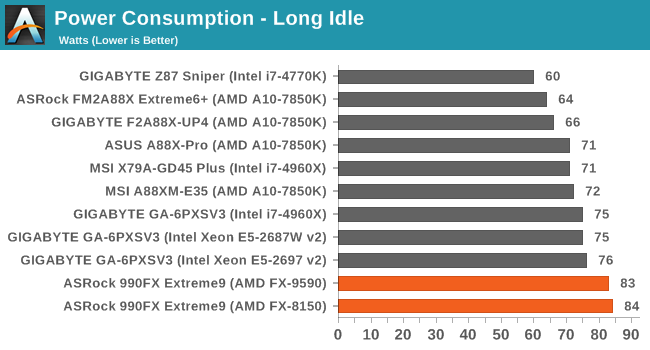
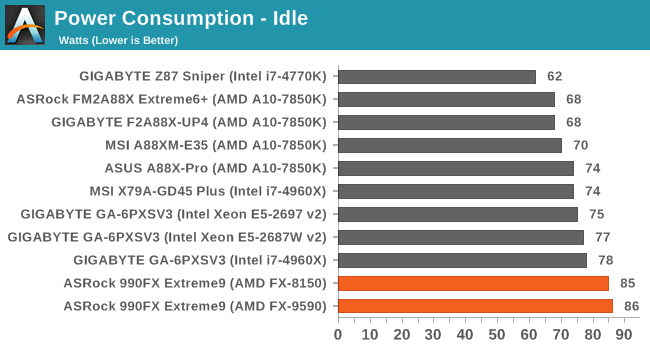
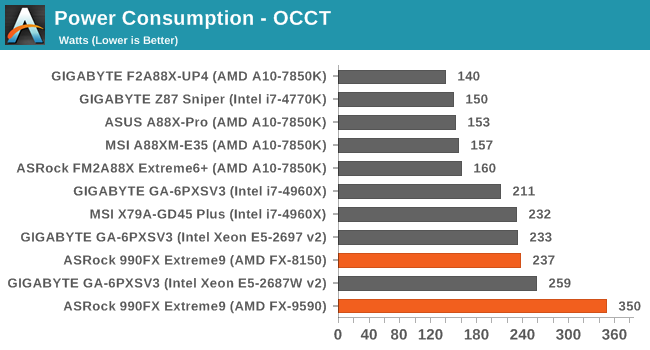
The added power draw of the FX-9590 is quite clear, showing 350W for the full system during a heavy CPU load. However, the idle power draw of the CPU is similar to that of the FX-8150.
Windows 7 POST Time
Different motherboards have different POST sequences before an operating system is initialized. A lot of this is dependent on the board itself, and POST boot time is determined by the controllers on board (and the sequence of how those extras are organized). As part of our testing, we are now going to look at the POST Boot Time - this is the time from pressing the ON button on the computer to when Windows 7 starts loading. (We discount Windows loading as it is highly variable given Windows specific features.) These results are subject to human error, so please allow +/- 1 second in these results.
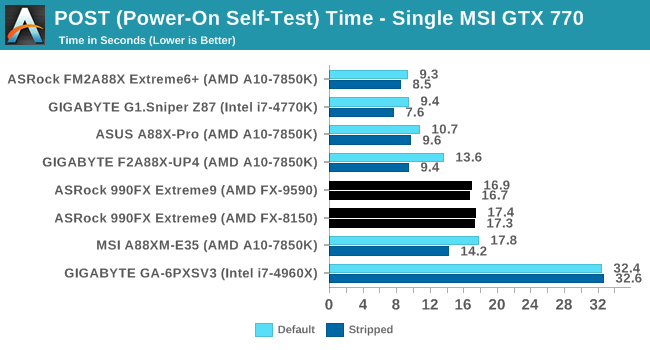
The FX-9590 afforded a shorter POST time than the FX-8150, although both are north of 16 seconds.
Rightmark Audio Analyzer 6.2.5
The premise behind Rightmark:AA is to test the input and output of the audio system to determine noise levels, range, harmonic distortion, stereo crosstalk and so forth. Rightmark:AA should indicate how well the sound system is built and isolated from electrical interference (either internally or externally). For this test we connect the Line Out to the Line In using a short six inch 3.5mm to 3.5mm high-quality jack, turn the OS speaker volume to 100%, and run the Rightmark default test suite at 192 kHz, 24-bit. The OS is tuned to 192 kHz/24-bit input and output, and the Line-In volume is adjusted until we have the best RMAA value in the mini-pretest. We look specifically at the Dynamic Range of the audio codec used on board, as well as the Total Harmonic Distortion + Noise.
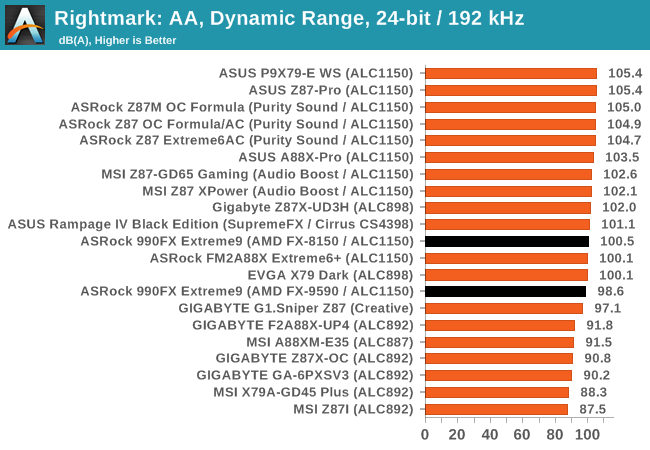
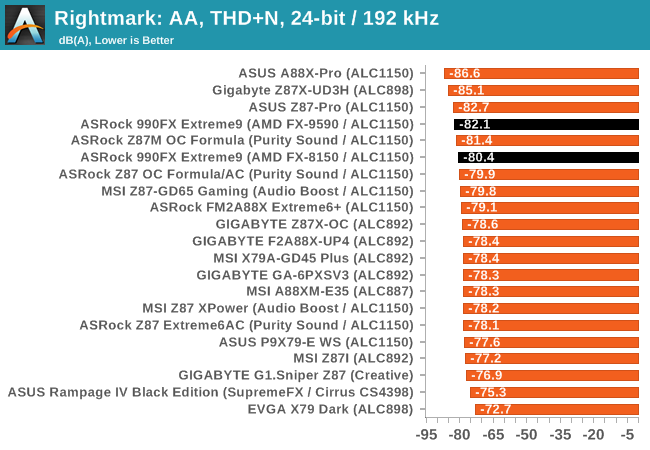
USB Backup
For this benchmark, we run CrystalDiskMark to determine the ideal sequential read and write speeds for the USB port using our 240 GB OCZ Vertex3 SSD with a SATA 6 Gbps to USB 3.0 converter. Then we transfer a set size of files from the SSD to the USB drive using DiskBench, which monitors the time taken to transfer. The files transferred are a 1.52 GB set of 2867 files across 320 folders – 95% of these files are small typical website files, and the rest (90% of the size) are the videos used in the WinRAR test. In an update to pre-Z87 testing, we also run MaxCPU to load up one of the threads during the test which improves general performance up to 15% by causing all the internal pathways to run at full speed.
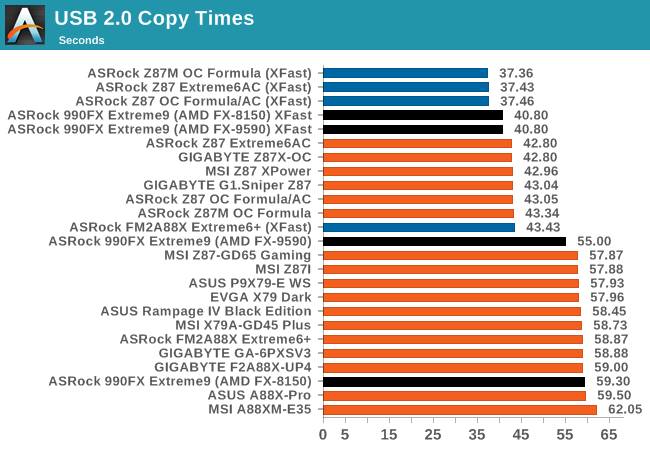
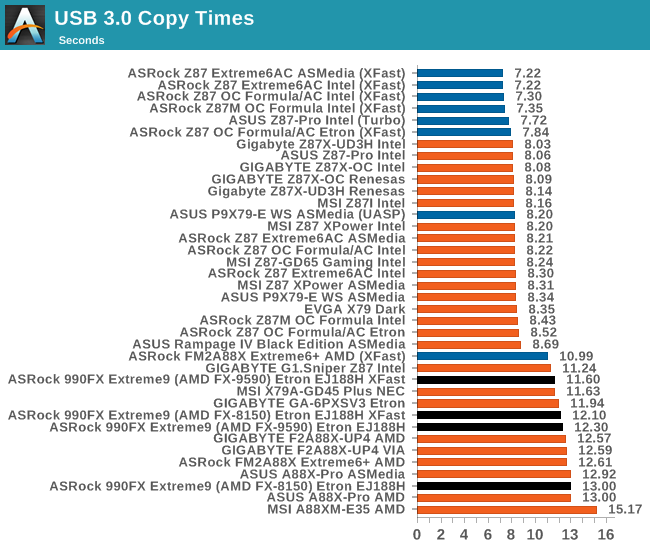
The increase in CPU speed of the FX-9590 gives a measured improvement in standard USB copy times – saving 4.3 seconds over the FX-8150 for USB 2.0 transfers. However using XFast USB eliminated that difference completely. For USB 3.0 transfers, using the Etron controller put a consistent advantage on the side of the FX-9590.
DPC Latency
Deferred Procedure Call latency is a way in which Windows handles interrupt servicing. In order to wait for a processor to acknowledge the request, the system will queue all interrupt requests by priority. Critical interrupts will be handled as soon as possible, whereas lesser priority requests, such as audio, will be further down the line. So if the audio device requires data, it will have to wait until the request is processed before the buffer is filled. If the device drivers of higher priority components in a system are poorly implemented, this can cause delays in request scheduling and process time, resulting in an empty audio buffer – this leads to characteristic audible pauses, pops and clicks. Having a bigger buffer and correctly implemented system drivers obviously helps in this regard. The DPC latency checker measures how much time is processing DPCs from driver invocation – the lower the value will result in better audio transfer at smaller buffer sizes. Results are measured in microseconds and taken as the peak latency while cycling through a series of short HD videos - less than 500 microseconds usually gets the green light, but the lower the better.
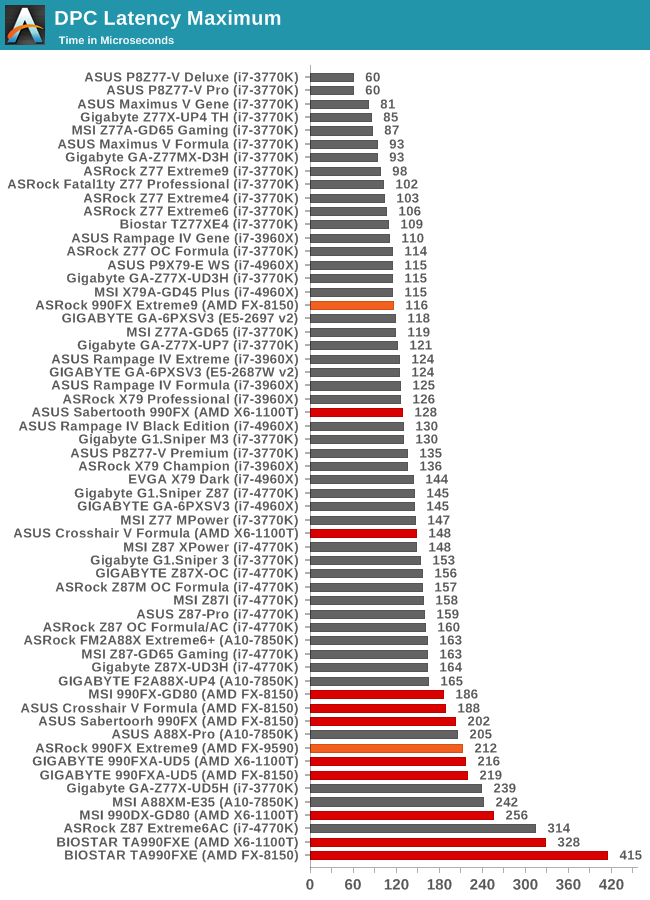
In a surprising twist, it would seem the FX-9590 has a disadvantage for DPC latency. I would have expected the faster processor to have the lower result, but one might speculate that the BIOS is tuned more for the mainstream processors such as the FX-8150. The chipset might also be geared more to the FX-8150 as it was the earlier generation compared to the FX-9590.










146 Comments
View All Comments
thejshep - Sunday, August 10, 2014 - link
But even if you more than double the wattage of an i7, you're still not approaching the wattage this cpu takesSkillztech - Friday, September 12, 2014 - link
Cause it is totally intel biasedSkillztech - Friday, September 12, 2014 - link
No need to over clock this chip at all, totally powerful. intel and the low voltage low power chips just suck at the same price range.TiGr1982 - Saturday, August 9, 2014 - link
This FX-9590 is actually the last year's product. E.g., in Canadian Canada Computers this SKU (in the version without any cooler) lays on the shelves for months and almost nobody buys it. At the same time, they have a big turnaround of Haswell Intel i7's, which speaks for itself."Re-release" of this SKU happens because AMD has nothing better to offer, so they hope to get some public attention which it better than zero public attention :)
I'm not an old man (age 32 now), but I remember the times (2005) when even Alienware top laptops were based on AMD Turions (rebranded Athlons 64) - simply because these were better than Intel's Pentium M at the time.
And, in contrast, in around last three years since Bulldozer release AMD CPU business looks poorly.
Yes, I know, APUs, OpenCL, HSA. But the CPU side of things at AMD is sad.
Da W - Monday, August 11, 2014 - link
AMD should just drop Bulldozer. That's probably what they're doing.Skillztech - Friday, September 12, 2014 - link
8 cores high multi tasking and usage with high end core hungry software leaving intel in the dust. Plus the ability to game awesome. A real CPU.Budburnicus - Saturday, January 10, 2015 - link
Intel's i7-2600K SPANKS this POS in every conceivable way! AND it is THREE years old! This is even at stock clocks, just TRY comparing this CPU in any overclock to an i7-2600K at 4.4 Ghz (and overclock that basically ANY 2600K can handle - I have mine at 4.7 and 102.3 Bclock)And with EVERY benchmark available - the 4.4 Ghz OC,ed i7-2600K will COMPLETELY blow this POS out of the water! (BTW Not only is 4.4 easy to hit, but the TDP never goes above 125 - even with my 4.7 OC, as stock TDP is only 95w!)
I USED to be an AMD "Fanboy" back in the days of Intel's Pentium 4 "Net Burst" architectural FLOP! And the Athlon XP' superior gaming performance and performance per dollar - with better overclocking!
But since PileDriver FIRST came out, I have only shuddered at the thought of this architecture even existing, let alone being pushed farther and farther! Intel KNEW Net Burst was horrible, and dumped it ASAP for first Core and then Core2 architectures - which were very competitive in all ways for their day.
On the eve of SandyBridge, once benchmarks became available it was OBVIOUS that the SandyBridge Architecture was game changing, especially since the about $350 (at release) i7-2600k - and even the $250 i5-2500K completely SPANKED even Intel's own i7-900X extreme edition CPUs whicbh cost about $1000!
Ever since AMD swallowed ATI it seems they really dropped the ball (in both courts!) Continuing this HIGHLY inefficient chip design - which is ACTUALLY only a Quad core - with just 2x the ALU's per core serving as a full "dual core" processing unit - they left out MANY components that make up a FULL core, and most importantly, while L2 cache is slightly larget than Intel's chips for the most part, the caches are MUCH slower! And a "Dual Core Unit" has twice the ALUs vying for L2 access, where L3 cache is INCREDIBLY slow at something like 200 GB/sec to ALL cores - where Intel's i7-2600K has 168 GB/sec DEDICATED PER CORE! And that is at stock speeds too!
So you have REALLY got to ask yourself, when a 3 year old Intel part - which by now is not only cheaper - but FAR more power efficient, is MUCH faster, at stock clock, than a BRAND new AMD part - which takes well over twice the power and puts out over twice the heat, WTF is th point in buying AMD?
Especially when one considers that on a CHEAP Z68 or Z77 chipset board - this three year old i7-2600K can EASILY hit 4.4 Ghz - and it will STILL be more power efficient than the AMD part - as well as multitudes faster in EVERY way that truly matters - this just seem sad for AMD...
They are eating more power, and crapping less performance - even per $! Unless you really want a bargain basement gaming PC - then an A10 APU with a cheap GFX card will be cheaper than an Intel build with similar performance (but we are talking $500 and less for a entirely new build!)
So this FX just represents a sad bit of AMD history, sure the hardcore "fan-boys" will cling tightly to their AMD parts they have invested money into - but (and there is always that BUT) everything about this new FX chip is far behind, and the ONLY reason one should even consider purchasing one is if they already own a good Socket AM3+ mobo - for new builds? AVOID AMD FX CHIPS LIKE THE PLAGUE!
SlowSpyder - Saturday, August 9, 2014 - link
For those who are running their CPU's at 100% load 24 hours a day, seven days a week, 365 days a year, this isn't the right CPU. That's likely a quite small population of people. There are cons to the FX 9xxx CPU's to be sure, but I don't think what are often over-blown energy usage costs are one of them.MatthiasP - Saturday, August 9, 2014 - link
The real problem is, there is not a single pro for this processor.SlowSpyder - Saturday, August 9, 2014 - link
For someone looking to build a new system, probably not a lot of pros. For AM3+ owners looking for an upgrade from a lower part and guaranteed clocks, there could be some value in this processor.